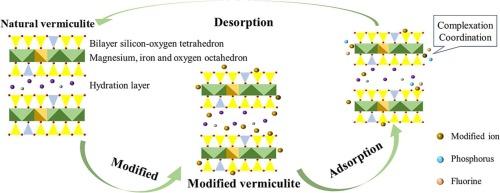Revealing the phosphorus and fluorine adsorption behavior of (modified) vermiculite: Enhancing comprehensive performance in phosphogysum leachate
IF 5
2区 工程技术
Q1 ENGINEERING, CHEMICAL
引用次数: 0
Abstract
Phosphogypsum leachate, generated through rainfall-induced erosion, contains high levels of soluble phosphorus (P) and fluorine (F), posing serious environmental risks. This study employs a facile modification method that increases the surface area of vermiculite up nearly 100 times, while introducing abundant cation active sites for adsorption of P and F. The A1 adsorbent exhibited the best performance in removing soluble P and soluble F. Under optimal conditions (pH 11, adsorbent dosage of 5.5 g·L-1, adsorption time of 480 min, and adsorption temperature of 50 °C), the adsorbent exhibited selective adsorption for soluble P and soluble F (with a selective adsorption preference difference of 79.71). Scanning electron microscopy (SEM) and transmission electron microscopy (TEM) revealed that the surface of modified vermiculite covered with dense nanoparticles and stacking pores, which expose more active sites. Combined with X-ray photoelectron spectroscopy (XPS) analysis, the adsorption of P and F occurs primarily through surface complexation via ligand exchange. Regeneration studies revealed that A1 exhibited good desorption and regeneration performance, which retained 75 % of P and 44 % of F adsorption capacity after six regeneration cycles.

揭示(改性)蛭石对磷、氟的吸附行为:提高磷石膏渗滤液的综合性能
磷石膏渗滤液是由降雨侵蚀产生的,含有高浓度的可溶性磷(P)和氟(F),构成严重的环境风险。本研究采用简单改性的方法,使蛭石的表面积增加了近100倍,同时引入了丰富的吸附磷和氟的阳离子活性位点。在最佳条件下(pH为11,吸附剂用量为5.5 g·L-1,吸附时间为480 min,吸附温度为50℃),A1吸附剂对可溶性磷和可溶性氟的去除效果最好。该吸附剂对可溶性磷和可溶性F均表现出选择性吸附(选择性吸附偏好差为79.71)。扫描电镜(SEM)和透射电镜(TEM)观察发现,改性后的蛭石表面覆盖了致密的纳米颗粒和堆积孔隙,暴露出更多的活性位点。结合x射线光电子能谱(XPS)分析,P和F的吸附主要通过配体交换的表面络合发生。再生研究表明,A1具有良好的脱附和再生性能,经过6次再生循环后,其对P和F的吸附量分别保持在75%和44%。
本文章由计算机程序翻译,如有差异,请以英文原文为准。
求助全文
约1分钟内获得全文
求助全文
来源期刊

Minerals Engineering
工程技术-工程:化工
CiteScore
8.70
自引率
18.80%
发文量
519
审稿时长
81 days
期刊介绍:
The purpose of the journal is to provide for the rapid publication of topical papers featuring the latest developments in the allied fields of mineral processing and extractive metallurgy. Its wide ranging coverage of research and practical (operating) topics includes physical separation methods, such as comminution, flotation concentration and dewatering, chemical methods such as bio-, hydro-, and electro-metallurgy, analytical techniques, process control, simulation and instrumentation, and mineralogical aspects of processing. Environmental issues, particularly those pertaining to sustainable development, will also be strongly covered.
 求助内容:
求助内容: 应助结果提醒方式:
应助结果提醒方式:


